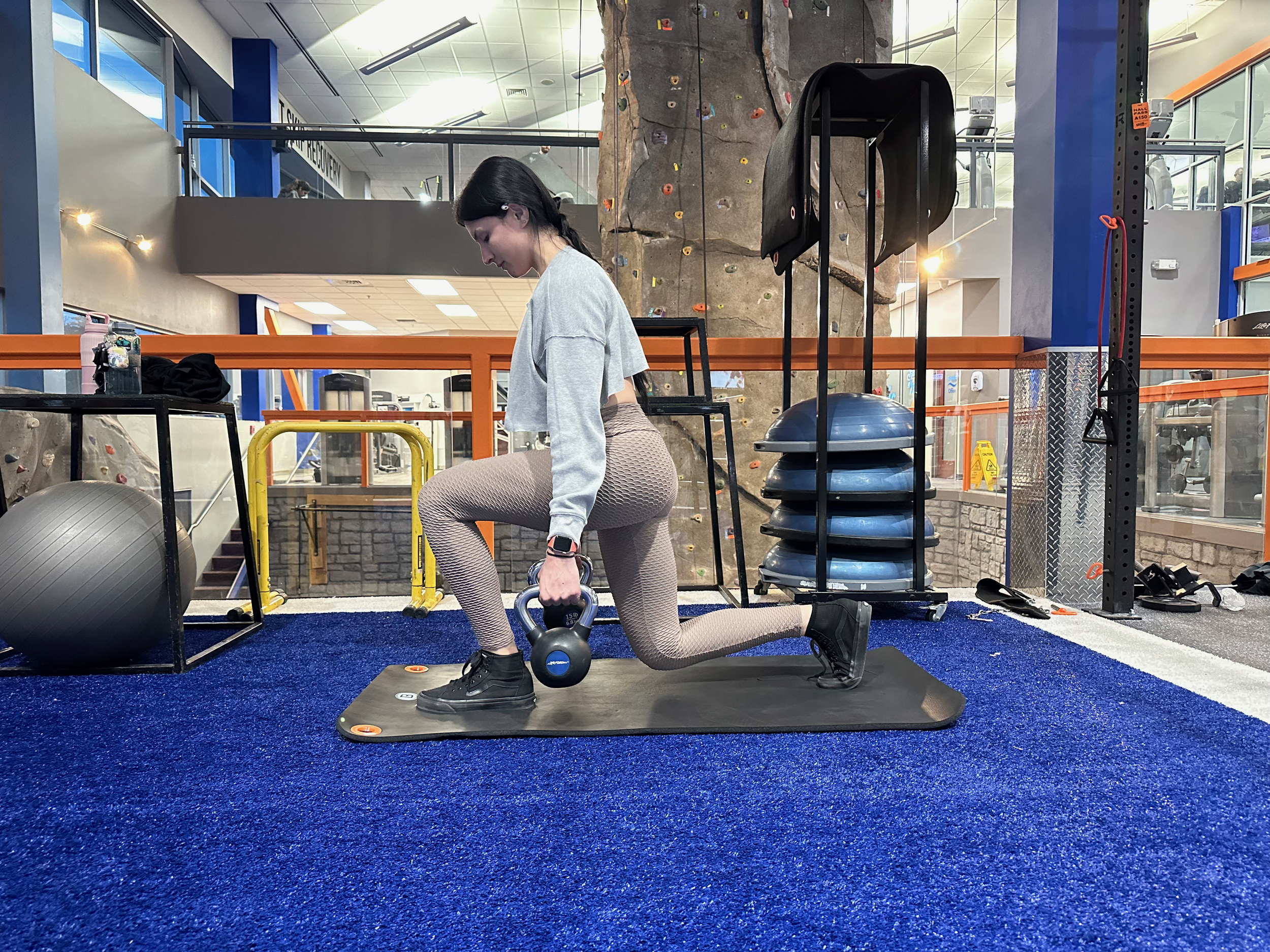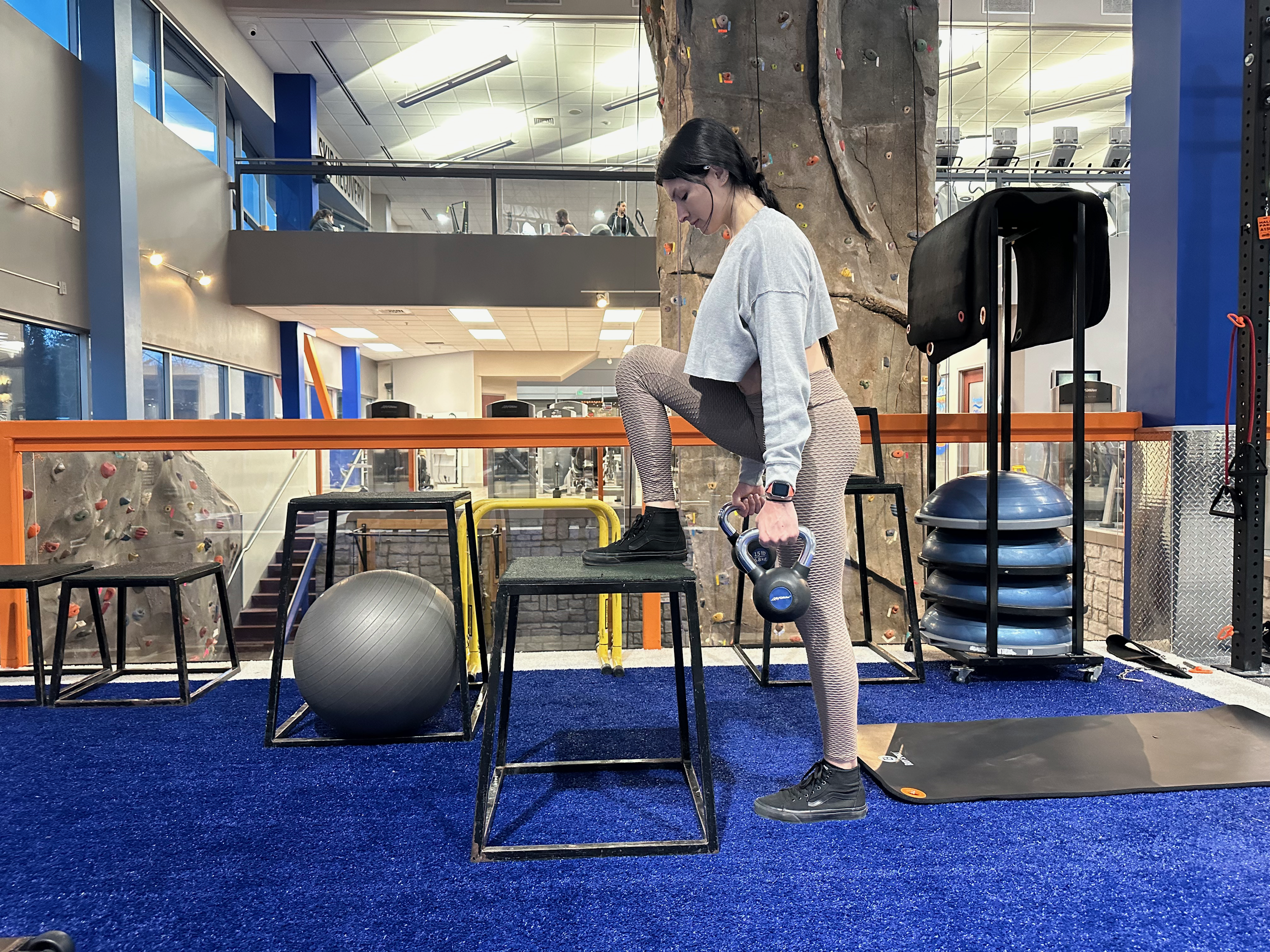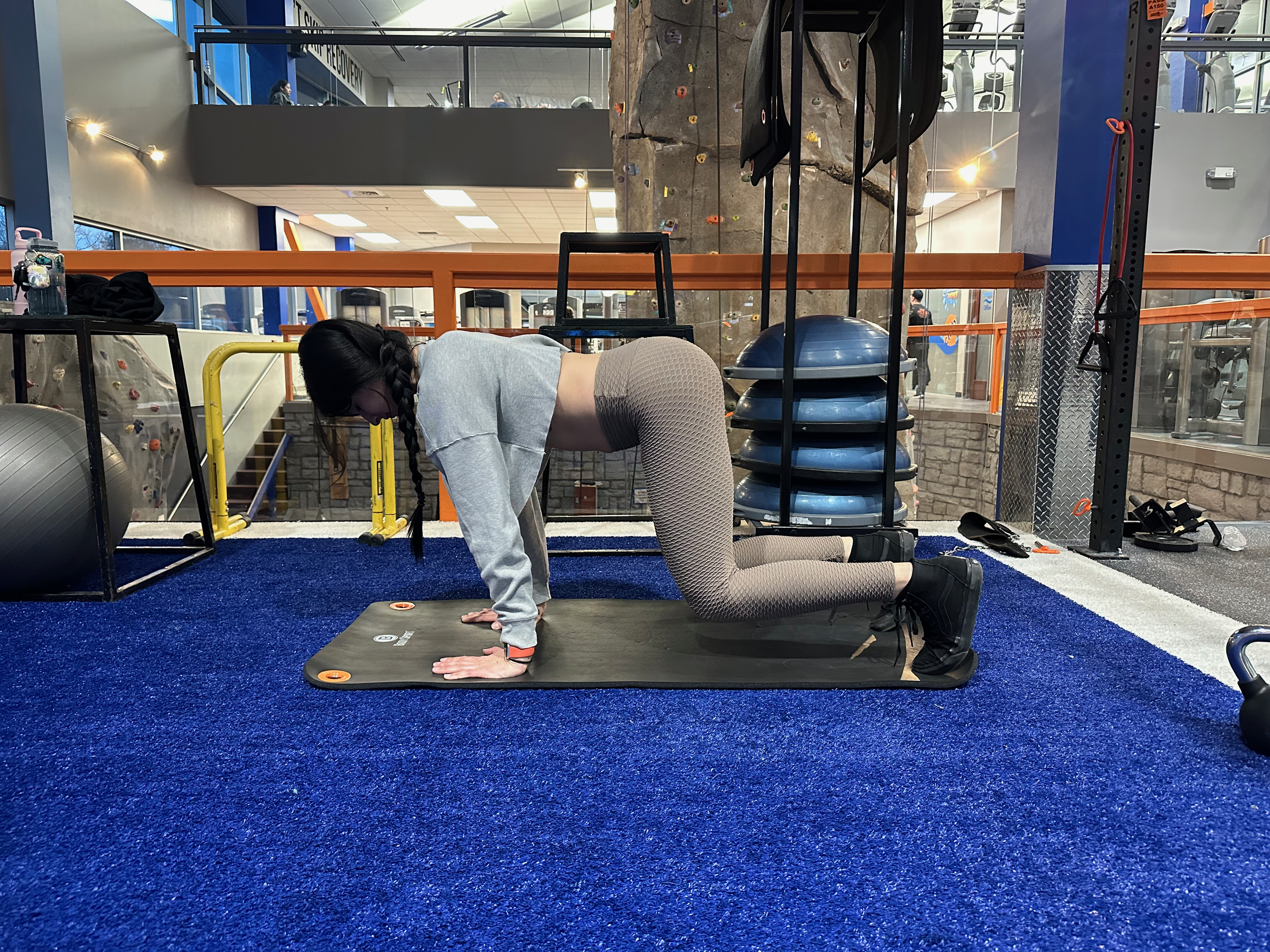How to Strength Train for Hiking, According to a Certified Personal Trainer
Hikers admiring a view as they step up the headwall of Kings Ravine Trail.
If you’ve ever hiked on a long, steep trail in the mountains, then you know how tough it can be. Avid hikers have all been there—when you’re already exhausted from the hours you’ve spent on trail and you’re continuing to climb at an incline that burns out your quads (and joy), it’s a challenging task. Plus, don’t forget the heavy hiking backpack thats been weighing on your back all day long.
While this may sound daunting, don’t let it steer you away from the sport. If you’re wondering how to best prepare your body for anything from short walks in the woods to 20-mile traverses, you can start by adding strength training to your exercise routine. To help you discover how to best strength train for hiking, I spoke to Sarah LaCourse, a Certified Personal Trainer, Certified Sports Nutritionist, and hiker of the rugged White Mountains.
Listen to Sarah’s podcast, Episode 1: strength training for hiking, gaining muscle, and protein during endurance exercise.
Reasons to Strength Train for Hiking
When you’re strengthening the muscles that you use while hiking, you’ll have an easier time sustaining different movement patterns on trail, such as stepping over roots and rocks, climbing uphill, and moving your body in different directions. Having muscle on your body also protects your joints.
“Strength training can reduce the risk of injury because we’re loading our muscle tissues [with weight],” says LaCourse.
The Best Exercises to Strength Train for Hiking
Here are the best exercises to make you a stronger hiker, according to LaCourse:
Lunges
Backward Lunge
Lunges are great for building your lower body and improving balance.
Lunges are a great exercise since there are so many different variations you can do. Lunges are a single-limb movement, so they also help with balance. Focusing on balance is great for hikers since they often step onto wobbly rocks, ice, go over river crossings, cross bridges, and wear snowshoes. Start with forward lunges, backward lunges, static lunges, lateral lunges, or walking lunges. Advanced lifters can perform pendulum lunges, which is when you move from a forward lunge to a back lunge.
Lunges can be performed with bodyweight or resistance and are a great exercise for targeting your lower body—primarily your quads, but also hamstrings, glutes, and calves.
2. Step Ups
Forward Step Up
Step ups mimic one of the most common hiking movements when you’re climbing a steep trail.
One of the most common movements hikers perform on trail is step ups. Think about how your body is moving when you’re climbing uphill—you place your foot on a rock and push off your front foot to climb to the next rock—that is why adding step ups to your routine is so beneficial. Use a box, bench, or if you’re strength training at home, you can use a couch, chair, small table, or set of stairs. LaCourse suggests performing lateral step ups as well since we aren’t always stepping up onto rocks and branches in a forward movement, but also side movements.
“Sometimes, I’ll even have folks do a lunge and then go into a step up,” says LaCourse.
Step ups can be performed with bodyweight or resistance and are a great exercise for targeting your lower body—primarily your quads, but also hamstrings, glutes, calves, adductors and abductors, and core.
3. Glute Bridges
Bodyweight Glute Bridge
Glute bridges will help you engage the proper muscles while hiking.
“With hiking, sometimes folks can get a little more quad dominant going downhill if we’re not focusing on engaging our glutes and our hamstrings,” says LaCourse.
Performing glute bridges in the gym can help hikers focus on engaging their glutes and hamstrings while moving on trail, especially downhill. By doing these consistently, engaging the proper muscles while hiking starts to become natural. Glute bridges can be performed in various ways. Try single-leg glute bridges, putting one foot on the box, using a band around your quadriceps, or by doing just regular glute bridges.
Glute bridges can be performed with bodyweight or resistance and are a great exercise for targeting your lower body—primarily your glutes and hamstrings.
4. Dead Bugs
Dead Bug
Climb uphill with a strong core and good coordination by doing dead bugs.
Your body for this exercise is positioned exactly how you envision it—like a dead bug. For this one, you lay on your back, knees are over your hips and are at a 90-degree angle, arms are directly over your head, and wrists are stacked on your shoulders. You will then alternate limbs—left leg to right arm, and then switch. This is a great exercise for building core strength and working on coordination. Having good coordination will allow you to move seamlessly over roots and rocks.
Dead bugs can be performed with bodyweight or a stability ball and are a great exercise for targeting your abdominal muscles.
5. Bear Holds
Bear Hold
When you have better balance, you can move more easily over natural elements, such as river crossings.
The bear hold position hold is a great exercise for strengthening your core and improving balance. For bear holds, you hold up your bodyweight by placing your hands on the mat directly below your shoulders and with your knees below your hips. Then, you lift your knees off the ground and hold yourself in that position. Advanced lifters can also perform a bear crawl.
Bear holds are performed with bodyweight and are a great exercise for targeting your abdominal muscles.
6. Pulling Movements
Assisted Pull Up
Build a stronger back so you can carry your pack with more ease.
When it comes to activities like winter hiking and backpacking, we are carrying a backpack for a long period of time. Because of this, LaCourse says that it’s important to, “be able to pull back and hold that position so we’re not getting fatigued.” In order to do so, hikers should focus on pulling movements in the gym, such as lat pulldowns, pull-ups, and seated cable rows. Those who workout from home can use a set of dumbbells or bands to mimic specific pulling movements and reap the benefits of them.
Pulling movements can be performed with bodyweight or dumbbells, machines, bands, or other weighted objects, and are a great movement for targeting your back, biceps, and forearms.
Moving in the Three Planes of Motion While Hiking
While hiking, it’s easy to assume that we are only moving forward, or in the sagittal plane, which involves forward and backward movements, but this isn’t always the case. When it comes to movement, there are three planes of motion: the sagittal plane, frontal plane, which involves side to side movements, and the transverse plane, which involves rotational movements.
Sagittal Plane: Bicep Curls
Some movements in the sagittal plane include forward and backward lunges, forward and backward step ups, deadlifts, bicep curls, squats, walking, and pull-downs.
You may come across a section on trail where you need to step sideways over an awkward rock, or perhaps you’ll find yourself rotating around a tree. According to LaCourse, these movements are why training your body in each plane of motion is important.
Frontal Plane: Lateral Lunge
Some movements in the frontal plane include side lunges, side step ups, lateral shoulder raises, and lateral leg raises.
Transverse Plane: Russian Twist
Some movements in the transverse plane include woodchoppers, curtsy lunges, Russian twists, and side plank twists.
Cardiovascular Endurance and Hiking Performance
Hiking is an activity that focuses heavily on cardiovascular endurance. When someone says they want to become a stronger hiker, they usually mean that they want to hike faster and move with better stamina. While strength training helps significantly with this, incorporating cardiovascular training into your routine helps as well. Each person’s need for cardio will vary based on how much they’re hiking. According to LaCourse, you never want to be overtaxing or under-recovering. For example, those who hike three to five days per week will need less cardiovascular training than those who only hit the mountains on weekends or a couple days per week.
“If you’re hiking that much, you don’t need to be doing extra because it’s going to be way too much for your body,” says LaCourse.
Those who only hike a couple days per week can benefit by adding in some cardiovascular activity along with strength training to their routine. LaCourse also suggests working in different heart rate zones. For example, if you’re hiking or doing the StairMaster three days per week, casually, spend the fourth day pushing yourself a little bit harder to increase your heart rate.
Nutrition Tips for Those Who Strength Train for Hiking
To sustain a lifestyle where you both strength train and hike, you must fuel properly. Each individual’s nutrition needs will vary based on various factors, such as their age, weight, gender, and activity level. According to LaCourse, there are a few general nutrition guidelines that all individuals can follow. It’s important to make sure you’re not under-eating, especially if both strength training and hiking are a part of your routine. In addition, making sure you’re getting in enough protein and carbohydrates, especially after your workout, is key. Here are a few protein and carbohydrate combinations to consider eating after being active:
Greek yogurt, granola, and fruit, such as a banana or blueberries, and honey
Hard boiled eggs, cheese, and crackers
Oatmeal with protein powder
Grilled chicken with brown or white rice
Turkey and cheese sandwich
It’s also important to make sure you’re consuming enough energy from food and drinking a proper amount of electrolytes several days before your hike all the way to the day of. That way, you’ll feel ready to hit the trails!
The Balance Between Lifting, Hiking, and Recovery
While nutrition is a part of the recovery process, so is resting your body, since, “when we’re resting, and when we’re sleeping, is when we’re actually rebuilding and repairing [muscle tissue], and getting stronger,” says LaCourse. Although recovery needs vary per person, a good rule of thumb is to have one sold rest day and one active recovery day per week. An active recovery day could involve a gentle walk, stretch session, or yoga class.
While it may be tempting to push both strength training and hiking endurance goals at the same time, it isn’t the most sustainable way to approach this lifestyle. LaCourse recommends using winter to get stronger if you’re a summer hiker, or to use the shoulder seasons—fall and spring—to build muscle if skiing or other winter sports are your thing.
“[This approach is] sustainable and will hopefully keep you performing how you would like to and feeling good—being able to do these activities long term verses getting injured or burning out,” says LaCourse.
Sarah LaCourse
Reach out to Sarah if you’re looking for a program and specific guidance on how to get strong for hiking.












